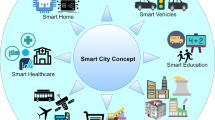Abstract
In this study, a method of implementation of cyber shopping services within a smart home environment with the use of sensor technology is proposed. This proposed model uses Radio Frequency Identification tag, Ubiquitous Sensor Network and TinyOS in order to transmit information to mobile interfaces. The residents and product information is collected and classified according to proposed categorization module and will generate the residents’ needed product advertisement. This proposed method of implementation provides an effective and convenient cyber shopping service environment to residents within their smart home environment and defines the service providers who support the cyber shopping.





Similar content being viewed by others
References
Abowd, G. D., Day, A. K., Brown, P. J., et al. (1999). Towards a better understanding of context and context-awareness. Proceedings of the First International Symposium on Handheld and Ubiquitous Computing HUC ‘99. Lecture Notes in Computer Science, Vol.1707.
Cook, D. J., Youngblood, M., Heierman, E., Gopalratnam, K., Rao, S., Litvin, A. et al. (2003). MavHome An Agent Based Smart Home. Proceedings of the IEEE International Conference on Pervasive Computing and Communications, 521–524.
Dey, A. K., Salber, D., & Abowd, G. D. (1999). A context-based Infrastructure for smart environments. Proceedings of the 1st International Workshop on Managing Interactions in Smart Environments, Dec 13.
Intille, S. S. (2002). Designing a home of the future. Journal of Pervasive Computing, 1(2), 80–86.
Kidd, C. D., Orr, R., Gergory, D., Abowd, G. D., Atkeson, C. G., & Essa, I. A. (2000). The aware home: a living laboratory for ubiquitous computing research. Heidelberg: Springer.
Meyer, S., & Rakotonirainy, A. (2003). A survey of research on context-aware homes. Proceedings of the Australasian information security workshop conference, 159–168.
Mozer, M. C. (2000). The neural network house: An environment that adapts to its inhabitants. In Geller, H. W. (ed.) Proceedings of International Symposium on Handheld and Ubiquitous Computing. London: Springer.
Roy, A., Das Bhaumik, S. K., Bhattacharya, A., Basu, K., Cook, D. J., Das, S. K. (2003). Location aware resource management in smart homes. Proceedings of the IEEE International Conference on Pervasive Computing and Communications, 481–488, Forth Worth, TX, USA.
Schmidt, A., Beigl, M., & Gellersen, H. W. (1998). There is more to context than location. Karlsluhe: University of Karlsluhe http://www.teco.uni-karlsruhe.de/~albrecht/publication/imc98.ps.
Author information
Authors and Affiliations
Corresponding author
Additional information
This work was supported by the Korea Research Foundation Grant (KRF-2008-013-D00107).
Rights and permissions
About this article
Cite this article
Song, Jg., Kim, S. A study on applying context-aware technology on hypothetical shopping advertisement. Inf Syst Front 11, 561–567 (2009). https://doi.org/10.1007/s10796-008-9125-0
Published:
Issue Date:
DOI: https://doi.org/10.1007/s10796-008-9125-0




